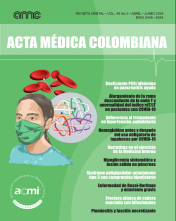Variations in hemoglobin levels before and after the isolation associated with the mandatory use of facemasks due to COVID-19
A laboratory data analysis
Abstract
Introduction: the isolation associated with the SARS-CoV2 coronavirus (COVID-19) pandemic called for multiple measures to reduce the impact of the disease, with one of the main ones being the use of facemasks. The use of facemasks is believed to potentially decrease the fraction of inspired oxygen and therefore stimulate the production of erythropoietin, thus causing hemoglobin variations.
Materials and method: a retrospective observational study was conducted based on an anonymized database to determine if there were variations in hemoglobin levels associated with the use of facemasks.
Results: a total of 224,415 complete blood counts drawn between January 2018 and March 2022 were included. The average hemoglobin in all the samples was 13.72 (95%CI 13.72-13.73); the average hemoglobin prior to May 2020 was 13.73 gr/dL and 13.72 after this date, with a statistically significant variation of 0.1 gr/dL (p:0.002).
Conclusion: there were significant hemoglobin level variations associated with the use of facemasks during the SARS-CoV2 pandemic isolation. By the same token, these differences are not thought to be clinically relevant today.
Metrics
Copyright (c) 2024 Gustavo Adolfo Parra Serrano, Héctor Henry Lindarte Vargas, Maria Paula Torres, Maria Alejandra Suta Figueroa, Maria Camila Flechas Alarcón, Carlos Alberto Correa Bernate, Diana Carolina Prada Robles, Sergio Serrano Gómez

This work is licensed under a Creative Commons Attribution 4.0 International License.
Acta Medica Colombiana uses the CC-BY 4.0 license. Authors retain all rights over their work.


